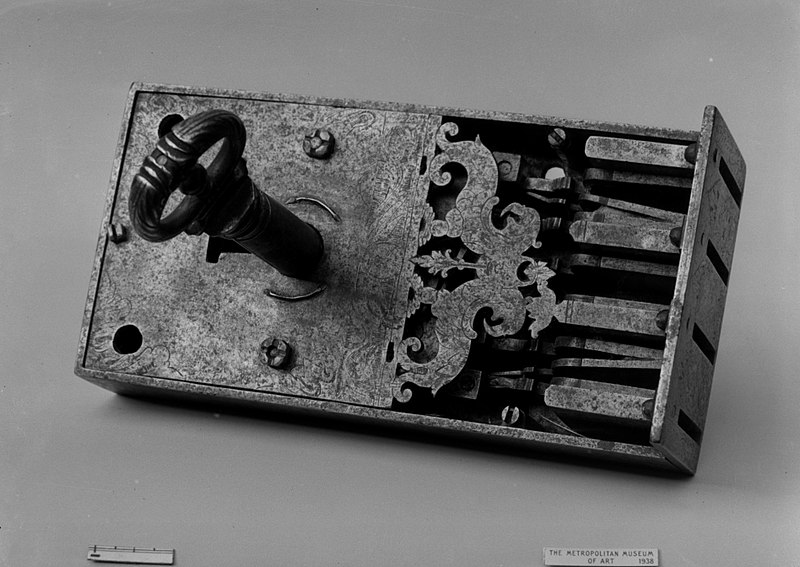How door locks work

|
| This iron metalwork object is a 16th century rim lock and key from France. |
Contents |
[edit] Introduction
A door lock is a mechanism used for security purposes - preventing a door from being opened by unauthorised people. There are many different types of door locks. Two of the most basic types of locks are rim locks and cylinder locks.
[edit] Rim locks
One of the oldest types of locks, the rim lock uses a bolt and key to secure the door. The bolt in the lock is moved when the correct key is inserted into the mechanism and turned. This action presses the tumbler - which is kept in place by a spring - up, and frees the bolt.
Next, the key bit engages with the corresponding notch under the bolt. Turning the key moves the bolt until the catch of the tumbler fits into next notch on the top of the bolt.
In simple locks, this completes the locking action. Greater safety is provided by a lock having not one, but several tumblers.
[edit] Cylinder locks
A cylinder lock uses a rotating mounted plug. When locked, the cylinder is held in place by several pin tumblers that have been moved into the proper position by springs. This allows the pins to fit into corresponding holes in the cylinder and keep the cylinder from moving.
A key is then inserted into the lock, which raises the pins so their tops move to a position that corresponds to the top of the outer surface of the cylinder. When the different segments of the tumbler are not connected, the cylinder can move freely when the key is turned. This allows the bolt to move and unlocks the door.
Another type of cylinder lock is the disc tumbler lock. This type of lock uses movable discs instead of pins to lock the cylinder.
[edit] Related articles on Designing Buildings Wiki
Featured articles and news
A change to adoptive architecture
Effects of global weather warming on architectural detailing, material choice and human interaction.
How big is the problem and what can we do to mitigate the effects?
Overheating guidance and tools for building designers
A number of cool guides to help with the heat.
The UK's Modern Industrial Strategy: A 10 year plan
Previous consultation criticism, current key elements and general support with some persisting reservations.
Building Safety Regulator reforms
New roles, new staff and a new fast track service pave the way for a single construction regulator.
Architectural Technologist CPDs and Communications
CIAT CPD… and how you can do it!
Cooling centres and cool spaces
Managing extreme heat in cities by directing the public to places for heat stress relief and water sources.
Winter gardens: A brief history and warm variations
Extending the season with glass in different forms and terms.
Restoring Great Yarmouth's Winter Gardens
Transforming one of the least sustainable constructions imaginable.
Construction Skills Mission Board launch sector drive
Newly formed government and industry collaboration set strategy for recruiting an additional 100,000 construction workers a year.
New Architects Code comes into effect in September 2025
ARB Architects Code of Conduct and Practice available with ongoing consultation regarding guidance.
Welsh Skills Body (Medr) launches ambitious plan
The new skills body brings together funding and regulation of tertiary education and research for the devolved nation.
Paul Gandy FCIOB announced as next CIOB President
Former Tilbury Douglas CEO takes helm.
UK Infrastructure: A 10 Year Strategy. In brief with reactions
With the National Infrastructure and Service Transformation Authority (NISTA).
Ebenezer Howard: inventor of the garden city. Book review.
Airtightness Topic Guide BSRIA TG 27/2025
Explaining the basics of airtightness, what it is, why it's important, when it's required and how it's carried out.





















